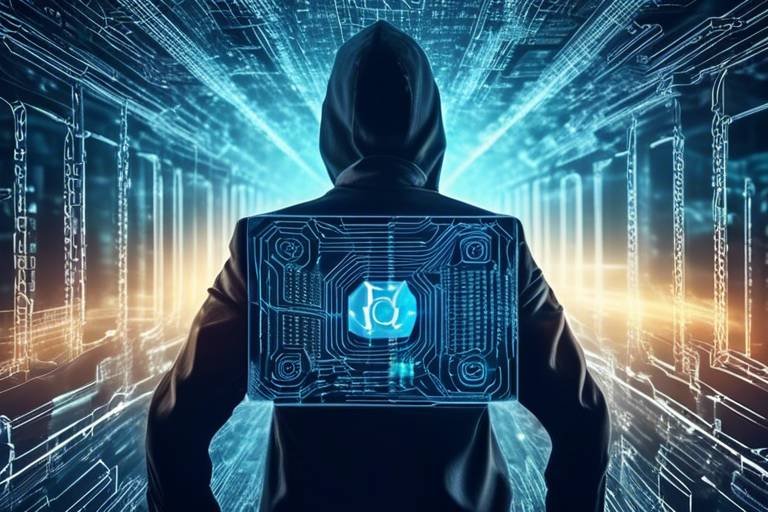How Blockchain Technology is Enhancing Cybersecurity Measures
In today's digital landscape, where cyber threats are becoming increasingly sophisticated, the need for robust cybersecurity measures has never been more critical. Enter blockchain technology, a game-changer that is revolutionizing how we approach data security. By leveraging its decentralized nature, blockchain not only enhances data integrity but also fortifies authentication processes across various sectors. Imagine a fortress where every brick is independently verified and cannot be altered without consensus; that’s the essence of blockchain in cybersecurity.
To fully appreciate how blockchain enhances cybersecurity, it's essential to grasp its core principles. At its heart, blockchain is a distributed ledger technology that allows data to be stored across a network of computers, or nodes, rather than being held in a single location. This decentralization means that no single entity has control over the entire database, which drastically reduces the risk of data tampering or unauthorized access. Key features of blockchain include immutability, which ensures that once data is recorded, it cannot be altered without altering all subsequent blocks, and transparency, where transactions can be viewed by all participants in the network, fostering trust.
Data integrity is the backbone of any effective cybersecurity strategy. In a world where data breaches can lead to catastrophic consequences, maintaining the accuracy and consistency of data is paramount. Blockchain technology ensures that data remains unaltered and securely recorded by employing cryptographic hashing. Each block in a blockchain contains a unique hash of the previous block, which creates a chain that is incredibly difficult to break. This feature effectively prevents unauthorized modifications and enhances trust in digital transactions. For organizations handling sensitive information, such as financial institutions or healthcare providers, the assurance that their data is secure can significantly reduce the risk of fraud and data breaches.
One of the most exciting applications of blockchain technology in cybersecurity is the use of smart contracts. These self-executing contracts with the terms of the agreement directly written into code can automate processes and enforce agreements without the need for intermediaries. This not only speeds up transactions but also reduces the likelihood of human error—a common vulnerability in traditional systems. Smart contracts can be programmed to trigger alerts or actions when certain conditions are met, providing an additional layer of security in various transactions.
Implementing smart contracts within existing cybersecurity frameworks requires careful planning and execution. Organizations must consider several factors, including the choice of blockchain platform, the design of the contract itself, and the integration with current systems. Potential challenges include ensuring compliance with legal standards and managing the technical complexity involved. However, with the right approach, these challenges can be addressed effectively, paving the way for a more secure transactional environment.
To illustrate the effectiveness of smart contracts in enhancing cybersecurity, let’s look at a few real-world examples. For instance, in the insurance industry, companies are employing smart contracts to automate claims processing. When a claim is submitted, the smart contract verifies the conditions of the policy and automatically releases payment if all criteria are met. This not only speeds up the process but also minimizes the risk of fraudulent claims. Similarly, in supply chain management, smart contracts can track the provenance of goods, ensuring that products are genuine and have not been tampered with during transit.
Identity management is a critical aspect of cybersecurity, and blockchain technology offers innovative solutions to enhance identity verification processes. Traditional identity management systems are often plagued by vulnerabilities, leading to identity theft and fraud. Blockchain technology can provide a secure and decentralized way to manage identities, allowing users to control their own data and share it selectively. By creating a digital identity on the blockchain, individuals can verify their identity without relying on centralized databases, significantly reducing the risk of data breaches.
Decentralization is a key feature of blockchain that enhances security across various applications. Unlike traditional systems that rely on a central authority, decentralized security solutions distribute data across multiple nodes, making it more resilient to attacks. Examples of decentralized solutions include distributed ledgers and peer-to-peer networks, which can provide enhanced security and reliability. These systems are inherently more difficult for hackers to penetrate since there is no single point of failure.
While decentralized security solutions offer numerous benefits, they also come with their own set of challenges. Scalability is a significant concern, as increasing the number of transactions can lead to slower processing times. Additionally, the lack of a central authority can complicate regulatory compliance, as organizations must navigate a patchwork of laws and regulations. Addressing these challenges will be crucial for the widespread adoption of decentralized security solutions in the future.
Looking ahead, the intersection of blockchain technology and cybersecurity is poised for exciting developments. Emerging trends include advancements in AI integration, which could enhance threat detection and response capabilities. Moreover, the implications of quantum computing are beginning to be explored, as its power could potentially undermine traditional encryption methods. The evolving regulatory landscape will also play a crucial role in shaping how blockchain is utilized in cybersecurity, as governments and organizations seek to create frameworks that foster innovation while ensuring security.
- What is blockchain technology?
Blockchain is a decentralized digital ledger that records transactions across multiple computers, ensuring that the data cannot be altered retroactively. - How does blockchain enhance cybersecurity?
By providing a secure and immutable way to store data, blockchain helps prevent unauthorized access and modifications, thereby enhancing data integrity. - What are smart contracts?
Smart contracts are self-executing contracts with the terms of the agreement directly written into code, which automate and secure transactions. - What are the challenges of implementing blockchain in cybersecurity?
Challenges include scalability, regulatory compliance, and the technical complexity of integrating blockchain solutions into existing systems.

The Basics of Blockchain Technology
Understanding blockchain technology is like unlocking a new dimension in the digital world. At its core, blockchain is a decentralized ledger that records transactions across many computers. This means that no single entity has control over the entire chain, making it incredibly resilient to tampering and fraud. Imagine a digital notebook that everyone can see and write in, but once something is written, it can't be erased or altered. That’s the essence of blockchain!
One of the key features of blockchain is its immutability. Once data is recorded in a block and added to the chain, it becomes nearly impossible to change. This is achieved through cryptographic hashing, where each block contains a unique hash of the previous block. If someone tries to alter a block, the hash will change, alerting the network to the tampering. This is why blockchain is often touted for its ability to ensure data integrity.
Another fundamental aspect is transparency. In a blockchain system, all participants have access to the entire chain, which fosters trust among users. For instance, in the case of financial transactions, both parties can verify the authenticity of the transaction without needing a third party. This transparency not only enhances trust but also simplifies auditing processes.
Blockchain operates on a peer-to-peer network, where each participant (or node) maintains a copy of the entire blockchain. This decentralized nature eliminates the need for a central authority, which is a significant departure from traditional systems that rely on centralized databases. In traditional systems, if the central server goes down, access to the data is lost. However, with blockchain, even if some nodes fail, the data remains accessible from other nodes in the network.
To summarize, the foundational principles of blockchain technology include:
- Decentralization: No single point of control.
- Immutability: Data cannot be altered once recorded.
- Transparency: All participants can view the entire chain.
- Peer-to-Peer Network: Each participant holds a copy of the blockchain.
As we delve deeper into the intersection of blockchain and cybersecurity, it’s essential to grasp these basic concepts. They lay the groundwork for understanding how blockchain can enhance security measures in various sectors, paving the way for more reliable and trustworthy digital interactions.
- What is blockchain technology? Blockchain is a decentralized digital ledger that records transactions across multiple computers.
- How does blockchain ensure data integrity? Through immutability and cryptographic hashing, once data is recorded, it cannot be altered.
- What are the benefits of decentralization? It eliminates single points of failure and enhances security by distributing data across a network.
- Can blockchain be hacked? While the technology is highly secure, vulnerabilities can exist in the applications built on top of it.

In the digital age, where data is the new gold, maintaining data integrity is paramount. Imagine a world where every transaction, every piece of information, is recorded in a way that ensures it cannot be altered or tampered with. This is where blockchain technology shines. At its core, blockchain operates as a decentralized ledger that records transactions across multiple computers. This means that no single entity has control over the entire database, reducing the risk of data manipulation and enhancing trust among users.
One of the most impressive features of blockchain is its immutability. Once data is entered into a blockchain, it becomes nearly impossible to change without consensus from the network. This characteristic is particularly crucial in cybersecurity, where unauthorized changes can lead to catastrophic consequences. For instance, in financial transactions, altering the details of a payment could result in significant financial loss or fraud. With blockchain, every transaction is time-stamped and linked to the previous one, creating a chain of evidence that is transparent and secure.
Furthermore, blockchain enhances data integrity through its transparency. All participants in the network can view the same data, which fosters accountability and reduces the chances of fraudulent activities. Think of it like a public library where every book is cataloged and available for anyone to check out. If someone tries to alter a book, the discrepancy will be evident to all, ensuring that the original content remains intact. This level of transparency is particularly beneficial in sectors like supply chain management, where verifying the authenticity of products is crucial.
To illustrate the impact of blockchain on data integrity, consider the following table that highlights key features and their benefits:
| Feature | Benefit |
|---|---|
| Immutability | Prevents unauthorized changes and fraud |
| Transparency | Builds trust among participants |
| Decentralization | Reduces single points of failure |
| Auditability | Facilitates easier tracking and verification of data |
In conclusion, the integration of blockchain technology into cybersecurity frameworks is a game-changer for ensuring data integrity. By leveraging its unique features, organizations can create a more secure environment that minimizes the risk of data breaches and fosters trust among users. As we continue to navigate the complexities of the digital landscape, embracing blockchain could very well be the key to safeguarding our data.
- What is blockchain technology? Blockchain is a decentralized digital ledger that records transactions across multiple computers, ensuring that the data cannot be altered without consensus.
- How does blockchain ensure data integrity? Through its features of immutability and transparency, blockchain prevents unauthorized changes and builds trust among participants.
- What are the benefits of using blockchain in cybersecurity? Blockchain enhances security by reducing the risk of data manipulation, increasing transparency, and providing an auditable trail of transactions.
- Can blockchain be used in all industries? Yes, blockchain can be applied across various industries, including finance, healthcare, supply chain management, and more, to enhance security and integrity.

Smart contracts are revolutionizing the way we think about security in the digital world. Imagine a contract that automatically executes when the conditions are met, eliminating the need for a middleman. This is the essence of smart contracts, and they are proving to be a game-changer in cybersecurity. By automating processes, smart contracts not only streamline operations but also enhance security measures significantly. They reduce the risk of human error, which is often a weak link in traditional security protocols. With smart contracts, you can ensure that every transaction is executed exactly as programmed, without any possibility for manipulation.
One of the most compelling features of smart contracts is their ability to enhance compliance. In sectors where regulations are strict, such as finance and healthcare, compliance is not just important; it's mandatory. Smart contracts can be programmed to adhere to specific regulations, ensuring that all parties involved are compliant without needing constant oversight. For instance, in a healthcare setting, a smart contract could automatically enforce patient data privacy regulations, ensuring that sensitive information is only shared when legally permissible. This not only protects the data but also builds trust among users.
Moreover, smart contracts facilitate greater transparency. Since they operate on a blockchain, all transactions are recorded on a public ledger that is immutable and traceable. This transparency allows for real-time auditing and monitoring, making it easier to spot and address any anomalies or unauthorized activities. Think of it as a security camera for your digital transactions—always watching, always recording, and always ready to provide evidence if something goes wrong. The ability to track changes and transactions enhances accountability among all parties involved, which is essential in maintaining a secure environment.
However, while the benefits of smart contracts in cybersecurity are clear, implementing them is not without its challenges. Organizations must ensure they have the right infrastructure in place, including robust blockchain technology and skilled personnel to manage these systems. Additionally, there is the matter of legal recognition—smart contracts must be recognized by existing laws to be enforceable. This is where collaboration with regulatory bodies becomes crucial. By working together, the tech community and lawmakers can create a framework that supports the safe and effective use of smart contracts in cybersecurity.
In conclusion, smart contracts are not just a buzzword; they represent a significant advancement in cybersecurity measures. By automating processes, ensuring compliance, and providing transparency, they offer a powerful tool for enhancing security in various industries. As we continue to embrace this technology, the potential for smarter, more secure transactions will only grow. The future of cybersecurity may very well rest on the shoulders of smart contracts, making it an exciting field to watch.
- What are smart contracts? Smart contracts are self-executing contracts with the terms of the agreement directly written into code. They automatically enforce and execute the contract when predefined conditions are met.
- How do smart contracts enhance cybersecurity? They reduce human error, ensure compliance with regulations, and provide transparency through immutable records on a blockchain.
- Are smart contracts legally binding? This depends on the jurisdiction. Some areas are beginning to recognize smart contracts legally, but it's essential to check local laws.
- What industries can benefit from smart contracts? Industries like finance, healthcare, supply chain, and real estate can greatly benefit from the automation and security that smart contracts offer.

Implementing smart contracts in cybersecurity frameworks can feel like stepping into uncharted waters, but it's a journey worth taking. First off, understanding the core principles of smart contracts is essential. These self-executing contracts with the terms of the agreement directly written into code can drastically reduce human error and enhance trust among parties. But how do we go from theory to practice? Let's break it down into manageable steps.
To begin with, organizations need to assess their current systems and identify areas where smart contracts can be integrated. This often involves conducting a thorough audit of existing processes. Once you've pinpointed the right opportunities, the next step is to choose a suitable blockchain platform that supports smart contract functionality. Popular options include Ethereum, Hyperledger, and Binance Smart Chain, each with its own unique features and benefits.
After selecting a platform, the next phase is to develop the smart contracts. This involves writing the contract code, which can be a complex task requiring skilled developers who are familiar with blockchain technology. It's crucial to ensure that the code is thoroughly tested before deployment. This is where the importance of security audits comes into play. By having external experts review the smart contracts, organizations can identify vulnerabilities and mitigate risks before going live.
Once the smart contracts are developed and tested, the deployment process begins. This is where the magic happens—once deployed, the contracts operate autonomously, executing transactions based on predefined conditions without the need for intermediaries. However, it's essential to monitor the contracts continuously to ensure they function as intended. Regular updates and maintenance are necessary to adapt to any changes in regulations or operational needs.
Despite the advantages, implementing smart contracts isn't without its challenges. For instance, organizations may face scalability issues as they grow, necessitating a flexible architecture that can accommodate increased transaction volumes. Moreover, the need for a robust regulatory framework cannot be overstated. As smart contracts operate in a decentralized environment, it’s vital to have guidelines that ensure compliance with legal standards.
In summary, implementing smart contracts in cybersecurity frameworks is a multi-step process that requires careful planning and execution. By conducting audits, selecting the right platform, developing secure code, and ensuring continuous monitoring, organizations can harness the power of smart contracts to enhance their security measures. It’s a leap into the future, where automation meets security, and trust is built into the very fabric of transactions.

Smart contracts are revolutionizing the way we approach security in various sectors, and real-world applications are showcasing their effectiveness. One notable example is the use of smart contracts in the insurance industry. Traditionally, insurance claims processing can be a cumbersome and lengthy process, often fraught with human error and fraud. However, by utilizing smart contracts, companies can automate the claims process. For instance, if a flight is delayed, a smart contract can automatically trigger compensation payments to affected passengers without any manual intervention. This not only speeds up the process but also enhances trust as all transactions are recorded on the blockchain, ensuring transparency.
Another compelling case study can be found in real estate transactions. The buying and selling of property often involves numerous intermediaries, which can lead to delays and increased costs. Smart contracts can streamline this process by allowing buyers and sellers to execute agreements directly. For example, a smart contract can hold the buyer’s funds in escrow and release them to the seller only when all conditions of the sale are met, such as the transfer of the property title. This not only reduces the risk of fraud but also ensures that both parties adhere to the agreed terms, fostering a more secure transaction environment.
Furthermore, the healthcare sector is also beginning to see the benefits of smart contracts. Patient data security is paramount, and smart contracts can enhance this by controlling access to sensitive information. For instance, a smart contract can be programmed to allow healthcare providers access to a patient’s medical records only after receiving explicit consent from the patient. This ensures that patient data remains confidential and secure, while also facilitating necessary access for treatment. By automating these processes, smart contracts minimize the potential for human error and unauthorized access, ultimately enhancing overall cybersecurity.
To illustrate the impact of smart contracts across different sectors, the table below summarizes key case studies and their outcomes:
| Sector | Application | Outcome |
|---|---|---|
| Insurance | Automated claims processing for flight delays | Faster payouts, reduced fraud |
| Real Estate | Direct transactions between buyers and sellers | Lower costs, reduced fraud |
| Healthcare | Controlled access to patient medical records | Enhanced data security, improved patient privacy |
These case studies highlight the transformative potential of smart contracts in enhancing security measures across various industries. By automating processes and reducing the reliance on intermediaries, smart contracts not only streamline operations but also significantly bolster cybersecurity protocols. As more organizations recognize these benefits, we can expect to see an increased adoption of smart contracts in the future.
Q: What are smart contracts?
A: Smart contracts are self-executing contracts with the terms of the agreement directly written into code. They automatically enforce and execute the contract when predetermined conditions are met.
Q: How do smart contracts enhance cybersecurity?
A: By automating processes and reducing human intervention, smart contracts minimize the risk of errors and fraud, ensuring that transactions are secure and trustworthy.
Q: Can smart contracts be used in any industry?
A: Yes, smart contracts can be applied across various sectors, including finance, real estate, healthcare, and supply chain management, to improve security and efficiency.

In today's digital age, identity management has become a critical pillar of cybersecurity. With increasing instances of data breaches and identity theft, the need for robust identity verification processes is more pressing than ever. Enter blockchain technology, a game-changer that can revolutionize how we manage identities online. By leveraging blockchain's decentralized and immutable nature, organizations can create a secure framework that not only enhances trust but also significantly reduces the risk of fraud.
So, how does blockchain improve identity management? Firstly, it provides a decentralized ledger where identities can be stored securely. Unlike traditional systems that rely on a central authority, a blockchain-based identity management system distributes the data across a network of nodes. This decentralization means that there’s no single point of failure, making it incredibly difficult for hackers to compromise the entire system. Furthermore, the use of cryptographic techniques ensures that personal data is encrypted and only accessible to authorized users.
Another significant advantage of using blockchain for identity management is its ability to enhance data integrity. Once an identity is recorded on the blockchain, it becomes nearly impossible to alter or delete that information without consensus from the network. This immutability ensures that the identity verification process is not only reliable but also trustworthy. In a world where data manipulation is rampant, having a system that guarantees the authenticity of identity records is invaluable.
To illustrate, consider a scenario where a person needs to verify their identity for accessing a secure service. Instead of providing multiple documents that can be forged or tampered with, they can use a blockchain-based identity that verifies their credentials through a simple cryptographic key. This process not only saves time but also enhances security by minimizing the amount of sensitive information shared during the verification process.
However, implementing blockchain for identity management does come with its own set of challenges. Organizations must navigate issues like user adoption, regulatory compliance, and the need for interoperability between different blockchain systems. Despite these hurdles, the potential benefits are too significant to ignore. As more organizations explore blockchain solutions, we can expect to see a shift towards more secure and efficient identity management practices.
In conclusion, blockchain technology holds the key to transforming identity management in a way that enhances security, trust, and efficiency. As we continue to witness the rise of cyber threats, embracing blockchain could very well be the answer to safeguarding our digital identities.
- What is blockchain technology? Blockchain is a decentralized digital ledger that records transactions across many computers in a way that the registered transactions cannot be altered retroactively.
- How does blockchain enhance identity management? It offers a secure, immutable, and decentralized way to store identity information, reducing the risk of fraud and enhancing trust.
- What are the challenges of using blockchain for identity management? Challenges include user adoption, regulatory compliance, and the need for interoperability between different blockchain systems.
- Can blockchain completely eliminate identity theft? While blockchain significantly reduces the risk, no system can guarantee complete security. However, it can minimize vulnerabilities.

In the rapidly evolving landscape of cybersecurity, decentralized security solutions are emerging as a game-changer. Unlike traditional security measures that rely heavily on centralized systems, decentralized solutions leverage the power of blockchain technology to create more robust and resilient security frameworks. Imagine a fortress where every brick is independently verified and cannot be easily tampered with; that’s the essence of decentralization in cybersecurity.
One of the most significant advantages of decentralized security is its ability to distribute risk. In a centralized system, a single point of failure can lead to catastrophic breaches. However, with decentralized networks, data is spread across multiple nodes, making it incredibly difficult for cybercriminals to compromise the entire system. For instance, if a hacker attempts to infiltrate one node, they would face an uphill battle against the numerous other nodes that maintain the integrity of the network. This distribution not only enhances security but also fosters trust among users, as they can independently verify transactions and data integrity.
Furthermore, decentralized security solutions often utilize distributed ledgers and peer-to-peer networks. These technologies allow for real-time data sharing and collaboration without the need for intermediaries. Consider a traditional bank transaction: it typically involves multiple parties, each with their own set of protocols and security measures. In contrast, a decentralized approach enables direct peer-to-peer transactions that are recorded on a public ledger, ensuring transparency and accountability. This not only streamlines processes but also reduces the chances of fraud.
Moreover, the use of cryptographic techniques in decentralized security further fortifies the system. Every transaction is encrypted and linked to previous transactions, creating a chain of blocks that is virtually impossible to alter. This immutability is a cornerstone of blockchain technology, ensuring that once data is recorded, it remains unchanged. As a result, organizations can maintain a secure and accurate record of all transactions, which is crucial for compliance and auditing purposes.
However, it’s essential to recognize that decentralized security solutions are not without their challenges. For example, while decentralization enhances security, it can also lead to scalability issues. As the number of users and transactions grows, maintaining the performance and efficiency of the network becomes increasingly complex. Additionally, the lack of a centralized authority can complicate governance and regulatory compliance. Organizations must navigate these challenges carefully to fully harness the benefits of decentralization.
In conclusion, decentralized security solutions hold immense potential in transforming how we approach cybersecurity. By distributing risk, utilizing distributed ledgers, and employing cryptographic techniques, these solutions can significantly enhance security measures across various sectors. As we continue to explore and innovate in this space, the future looks promising for organizations willing to embrace this paradigm shift.
- What are decentralized security solutions?
Decentralized security solutions leverage blockchain technology to distribute data across multiple nodes, enhancing security by eliminating single points of failure. - How do decentralized systems improve trust?
Users can independently verify transactions and data integrity, fostering a higher level of trust in the system. - What are the challenges of decentralized security?
Challenges include scalability issues and the complexity of governance without a centralized authority. - Can decentralized security solutions prevent all cyber threats?
No system is entirely foolproof, but decentralized solutions significantly reduce the risk of breaches and fraud.

While the promise of decentralized security solutions is enticing, it’s essential to recognize that they are not without their own set of challenges. One of the primary hurdles is scalability. As more users and transactions are added to a decentralized network, the system must be able to handle increased loads without compromising performance. This is particularly crucial in high-traffic environments, where speed and efficiency are paramount. Imagine trying to fit a growing number of passengers into a train that was designed for a much smaller crowd—eventually, it will become overcrowded, leading to delays and frustration.
Another significant challenge is the complexity of implementation. Transitioning from traditional centralized systems to decentralized ones requires a substantial rethinking of existing processes and infrastructures. Organizations may struggle with integrating new technologies, training staff, and ensuring that all components work seamlessly together. This complexity can lead to increased costs and extended timelines for deployment, which may deter some businesses from making the switch.
Additionally, there are regulatory concerns that cannot be overlooked. The decentralized nature of blockchain technology often places it outside the purview of traditional regulatory frameworks. This can create uncertainty for organizations that want to implement decentralized solutions but are unsure of how they will be viewed by regulators. For instance, companies may face legal challenges regarding data privacy and compliance with existing laws, which can hinder their ability to fully embrace decentralized security measures.
Furthermore, the issue of user adoption poses a challenge. Many individuals and organizations are still unfamiliar with blockchain technology and its benefits. This lack of understanding can lead to resistance to change, as people tend to be wary of adopting something they do not fully comprehend. Education and outreach efforts are crucial to overcoming these barriers and fostering a more widespread acceptance of decentralized security solutions.
In summary, while decentralized security offers numerous advantages, it also presents challenges that must be addressed. From scalability and implementation complexities to regulatory uncertainties and user adoption issues, organizations must navigate these hurdles to fully leverage the benefits of decentralized systems. The journey may be fraught with obstacles, but the potential rewards—enhanced security, improved data integrity, and greater trust—make it a worthwhile endeavor.
- What is decentralized security?
Decentralized security refers to security measures that are distributed across a network rather than being managed by a single central authority. This approach enhances resilience and reduces the risk of centralized points of failure.
- How does blockchain improve cybersecurity?
Blockchain enhances cybersecurity by providing immutable records, ensuring data integrity, and enabling secure transactions without the need for intermediaries, thereby reducing the risk of fraud and unauthorized access.
- What are the main challenges of decentralized security?
The main challenges include scalability issues, complexity of implementation, regulatory concerns, and user adoption barriers.

The future of blockchain technology in the realm of cybersecurity is not just promising; it's downright exhilarating! As we stand on the brink of a technological revolution, the integration of blockchain with cybersecurity measures is set to redefine how we protect our digital assets. Imagine a world where your data is not only secure but also verified and immutable, a realm where fraud becomes nearly impossible. Sounds like science fiction, right? Well, it’s closer than you think!
One of the most exciting trends is the integration of artificial intelligence (AI) with blockchain technology. AI can analyze vast amounts of data and detect anomalies that might indicate a security breach. When combined with blockchain's immutable ledger, this creates a powerful defense mechanism. Picture this: AI algorithms continuously monitoring transaction patterns on a blockchain network, instantly flagging any suspicious activity. This synergy could drastically reduce response times to potential threats, keeping sensitive data safe.
Another trend worth noting is the implications of quantum computing on blockchain security. While quantum computers promise incredible processing power, they also pose a threat to traditional encryption methods. However, blockchain technology is evolving to counter these threats. Developers are actively working on quantum-resistant algorithms that will ensure the integrity and security of blockchain networks against the future capabilities of quantum computing. This proactive approach will help maintain trust in blockchain systems, even as technology advances at breakneck speed.
Moreover, the regulatory landscape surrounding blockchain and cybersecurity is also evolving. As governments and institutions begin to recognize the potential of blockchain, we can expect more comprehensive regulations to emerge. These regulations will not only help protect consumers but also foster innovation by providing a clear framework for businesses to operate within. The challenge will be to strike a balance between regulation and innovation, ensuring that new technologies can flourish without compromising security.
As we explore these trends, it's essential to consider the role of decentralized finance (DeFi) in enhancing cybersecurity. DeFi platforms, built on blockchain technology, are revolutionizing financial transactions by removing intermediaries. This decentralization reduces points of failure and the risks associated with centralized systems. However, with great power comes great responsibility; as DeFi grows, so too does the need for robust security measures to protect users from potential vulnerabilities.
In conclusion, the intersection of blockchain technology and cybersecurity is a dynamic landscape filled with potential. As we look to the future, we can anticipate innovations that will not only enhance security but also transform how we interact with digital systems. The blend of AI, quantum resistance, evolving regulations, and DeFi will create a robust framework for safeguarding our digital lives. The question remains: are we ready to embrace these changes and lead the charge into a more secure digital future?
- What is blockchain technology?
Blockchain is a decentralized digital ledger that records transactions across many computers securely and immutably.
- How does blockchain enhance cybersecurity?
By ensuring data integrity, providing transparent records, and reducing the risk of unauthorized modifications.
- What role does AI play in blockchain security?
AI can analyze transaction patterns and detect anomalies, enhancing the overall security of blockchain networks.
- Are there risks associated with blockchain technology?
Yes, while blockchain offers many advantages, challenges such as scalability and regulatory compliance need to be addressed.
Frequently Asked Questions
- What is blockchain technology?
Blockchain technology is a decentralized digital ledger system that records transactions across multiple computers. This ensures that the recorded data cannot be altered retroactively without the consensus of the network, making it highly secure and transparent.
- How does blockchain enhance cybersecurity?
Blockchain enhances cybersecurity by providing data integrity, which prevents unauthorized modifications. Its decentralized nature reduces single points of failure, and features like immutability and transparency help in detecting fraud and ensuring trust in digital transactions.
- What are smart contracts?
Smart contracts are self-executing contracts with the terms of the agreement directly written into code. They automate processes and enforce agreements without the need for intermediaries, which reduces human error and enhances compliance in transactions.
- Can you give examples of smart contracts in cybersecurity?
Sure! One example is how smart contracts can be used in identity verification processes. They can automatically validate user identities against a blockchain record, reducing fraud and ensuring secure access to systems.
- What are the challenges of decentralized security solutions?
While decentralized security solutions offer many benefits, they face challenges like scalability issues and the need for regulatory frameworks. Managing a decentralized network can also be complex, requiring robust governance and coordination among participants.
- What future trends are emerging in blockchain and cybersecurity?
Emerging trends include advancements in AI integration with blockchain for enhanced threat detection, implications of quantum computing for encryption, and a continuously evolving regulatory landscape that aims to keep pace with technological advancements.



















